|
Summary:
Every 120 years or so a dark spot glides across
the Sun. Small, inky-black, almost perfectly
circular, it's no ordinary sunspot. Not everyone
can see it, but some who do get the strangest
feeling, of standing, toes curled in the damp
sand, on the beach of a South Pacific isle....
Get the full
story from Science@NASA.
Page
1 | Page
2 | Page
3 | Page
4 | Page
5 | Page
6 | Page
7 | Page
8 | This is Page 9
| Page
10
| Page
11
| Page
12
| Page
13
| Page
14
| Page
15
Unless otherwise stated, all images are copyrighted
by the photographers.
|
| |
Photographer,
Location |
Images |
Comments |
|
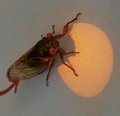
|
Herman
Heyn,
Baltimore, MD
Jun. 08, 2004 |
#1,
more |
"Every
17 years, a dozen states from Delaware to Illinois
are treated to a springtime emergence of the Brood
X (Magicicada septendecim) periodical
cicadas. The inch-and-one-half, red-eyed, winged,
noisy but harmless insects arrive in astronomical
numbers. Year 2004 CE is the first since 797 CE
that the two great periodical phenomena, a Brood
X emergence and a transit of Venus, have occurred
simultaneously. As there were no telescopes around
in 797 CE, this photograph taken June 8, 2004
in Baltimore's Druid Hill Park by astronomer Herman
M. Heyn, shows THE WORLD'S FIRST Brood X cicada
ever to watch a transit of Venus." |
|
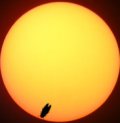
|
Kris
Culotta,
Baltimore, MD USA
Jun. 08 |
#1 |
And elsewhere in Baltimore...
Kris
Culotta photographed the silhouette of this cicada
crawling across his solar filter. "Fortunately
I had high speed mode on. Always have to be ready
for that opportunity!" says Kris. |
|
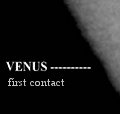
|
James
Kevin Ty,
Cebu City, Philippines
Jun. 08 |
#1,
#2 |
Images
were taken by James Kevin Ty of Astronomical League
of the Philippines (ALP) from Cebu City, Philippines
using TV-101 refractor with 2x Big Barlow and
Canon EOS 300D digital camera. Baader 3.8 Solar
Filter. 1/1000 sec exposure at ISO 100. |
|
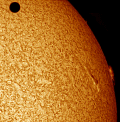
|
Jean-Louis
Badin,
Noisy le Grand , Seine St Denis, FRANCE.
Jun. 08 |
#1,
more |
Télescope
: Lunette Zeiss AS 100/1000 avec Coronado de 90
mm + Tune Max + BF 15. WebCam : ToUCam Pro capteur
N&B mode RAW. == Capture == Temps de pose : 1/1500
pour le globe. 1/250 pour la protubérance Nombre
d'images : 10 images par seconde pendant 30 secondes.
|
|
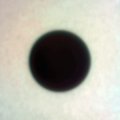
|
Alan
Murta,
North London, UK
Jun. 08 |
#1,
#2 |
Intes
MK-66 Deluxe 152/1800mm Maksutov, Toucam Pro webcam,
Baader solar filter. 450 video frames stacked.
2x Barlow used for close up. |
|
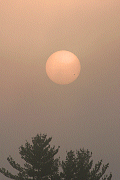
|
Larry
Landolfi,
Shot through early morning fog in Rochester, New
Hampshire
Jun. 08 |
#1 |
Canon
10D camera, Sigma 170-500 APO lens at 500mm (800mm
equivalent) |
|
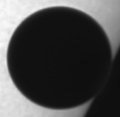
|
Ralf
Vandebergh,
Netherands,south of
Jun. 08 |
#1 |
This
image shows Venus during egress,and the atmosphere
of the planet is visible as a tiny ring just crossed
the solar limb. Taken with 6 inch FH refractor
and videocamera Sony TRV740E in normal mode |
|
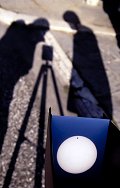
|
Boris
Stromar,
Zagreb, Croatia
Jun. 08 |
#1,
#2 |
Sun
projection through a 60mm russian refractor. Sequence
photographed with a Intes MN-71 + 2x barlow, artificial
color added. All taken with Nikon F80 & Konica
Centuria 100 slide. |
|
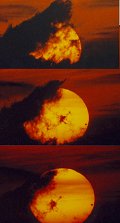
|
James
Holloway,
Newton Iowa USA
Jun. 08 |
#1 |
We
thought we where going to miss the transit and
then the sun climbed out of the clouds and gave
us a good look:) Olympus om1 400 asa 1/250s |
back to spaceweather.com
|
|